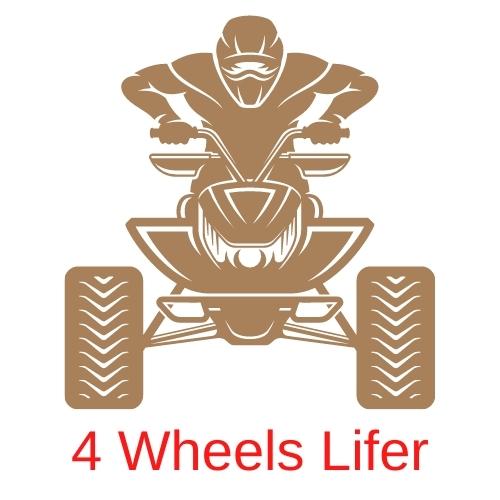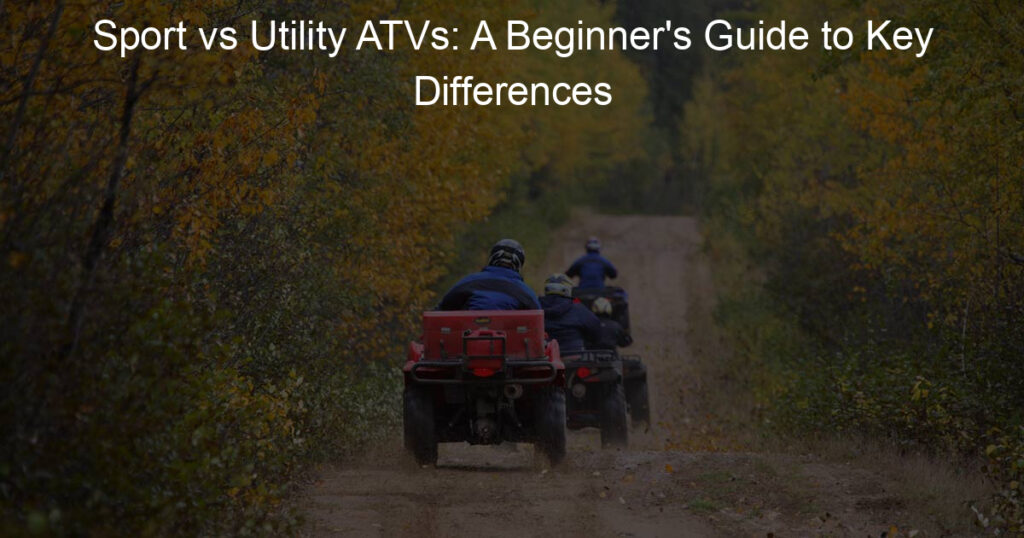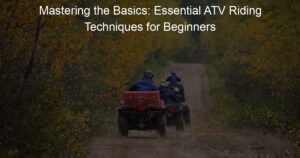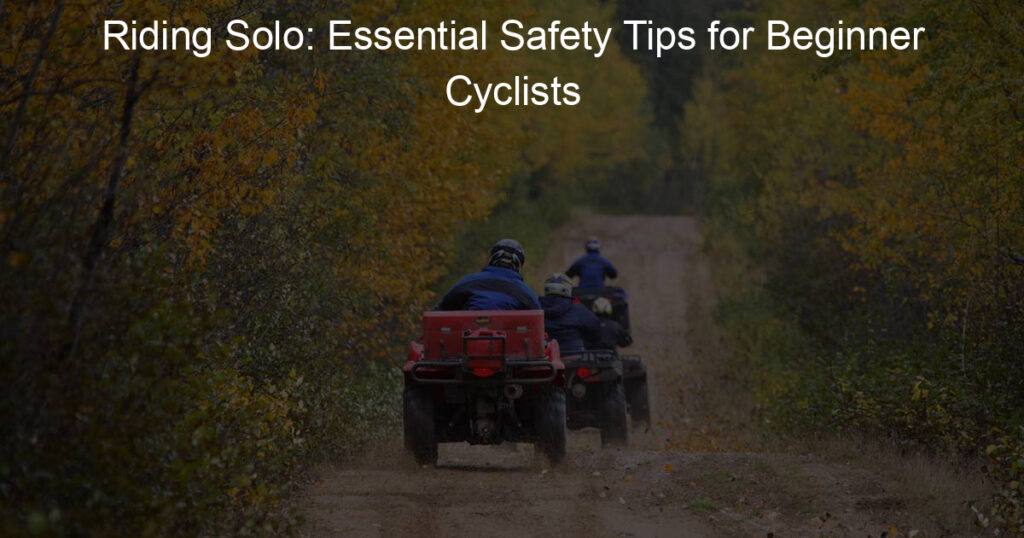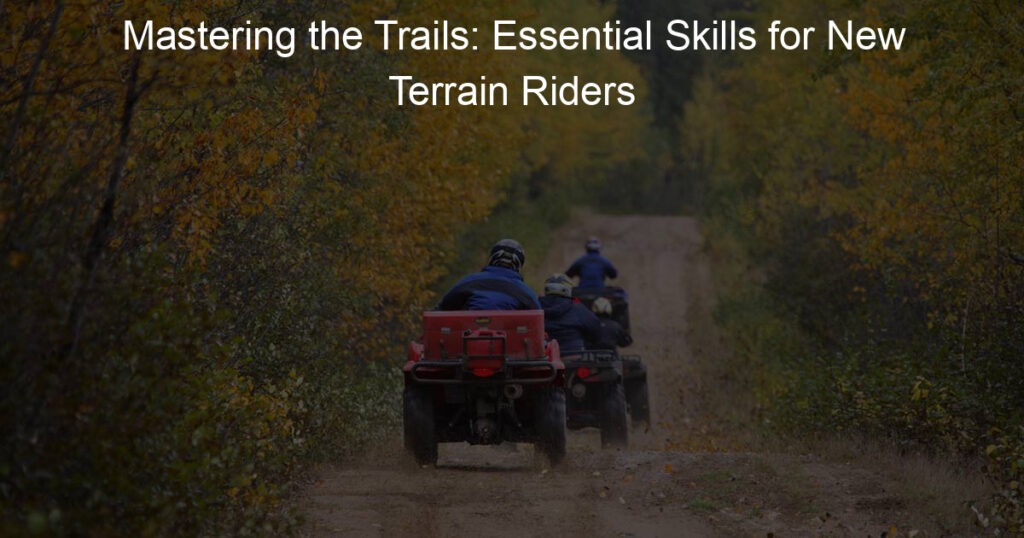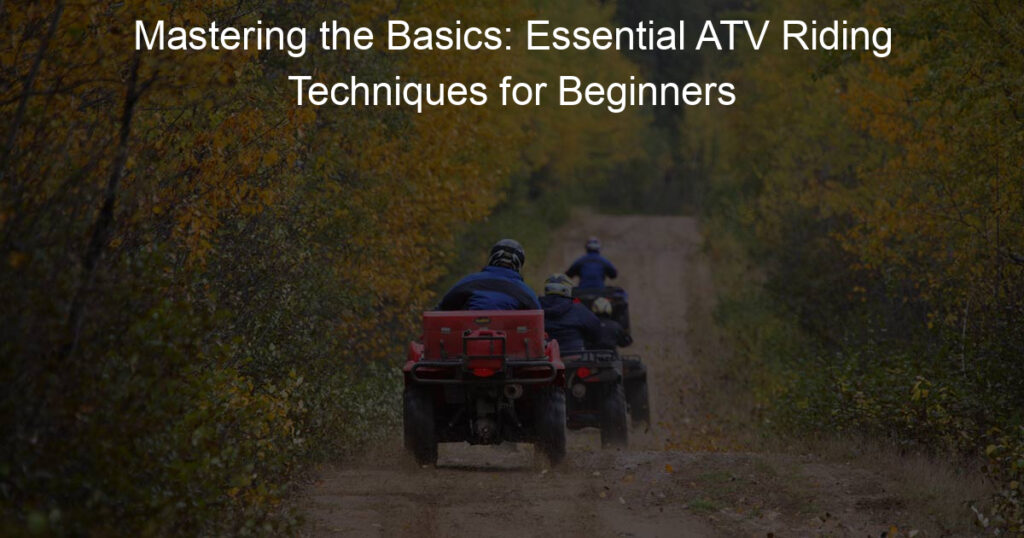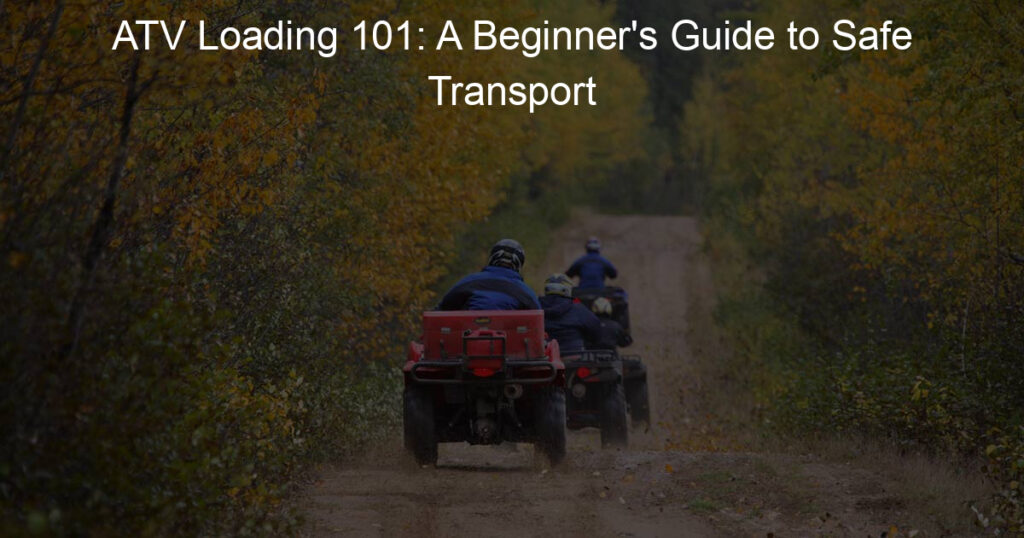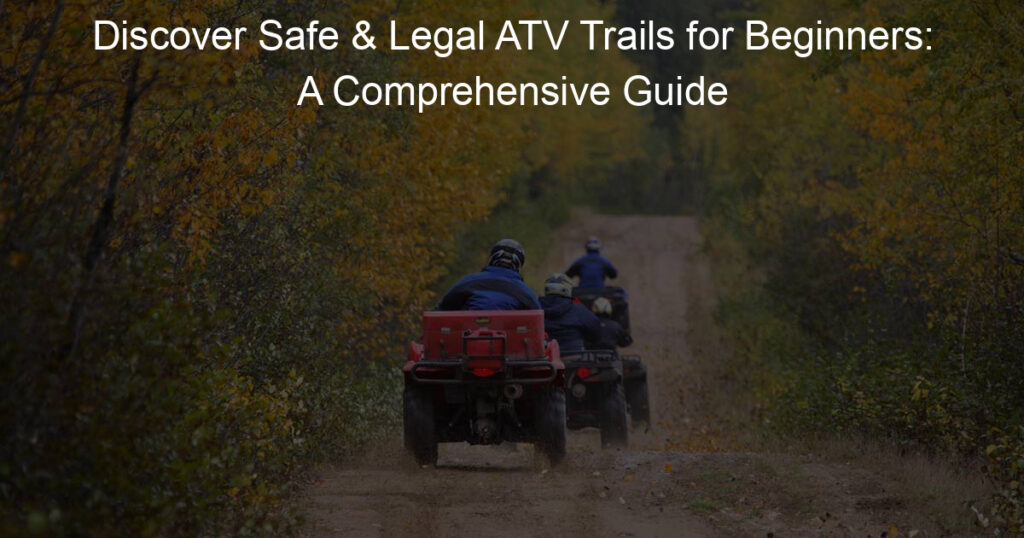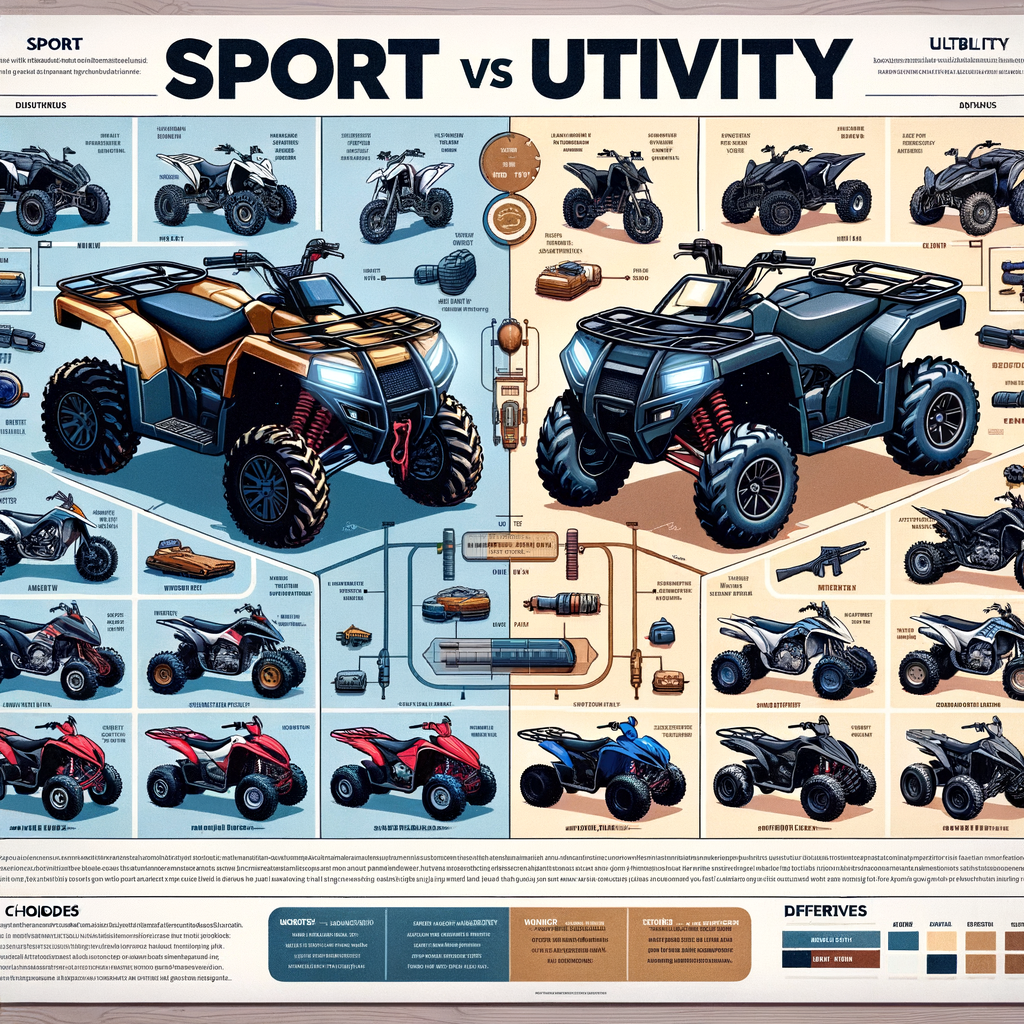
Introduction to ATVs for Beginners
Welcome to the exciting world of All-Terrain Vehicles (ATVs)! If you’re a beginner, this guide will help you understand what an ATV is, why they are so popular, and the various uses they have. Let’s dive in.
- Understanding what an ATV is
- The popularity and uses of ATVs
An ATV, or All-Terrain Vehicle, is a motorized off-highway vehicle designed to travel on four low-pressure tires. It has a seat that the operator straddles and handlebars for steering control. ATVs are built to handle a wider variety of terrain than most other vehicles, making them incredibly versatile.
ATVs are popular for both recreational and utility purposes. They are used in a variety of settings, from outdoor sporting events to farming and hunting. According to the Outdoor Industry Association, over 35 million Americans participated in ATV riding in 2019, demonstrating their widespread popularity.
Recreationally, ATVs are used for trail riding, racing, and even just for fun on private property. They provide a thrilling way to explore the outdoors and navigate challenging terrains. On the utility side, ATVs are used for tasks such as hauling small loads, plowing snow, or navigating rough terrain that larger vehicles can’t handle. They are a common sight on farms, construction sites, and in search and rescue operations.
In the following sections, we will delve deeper into the types of ATVs, their key differences, and how to choose the right one for you as a beginner. So, stay tuned!
Types of ATVs: Sport vs Utility
Sport ATVs for Beginners
If you’re new to the world of ATVs, you might be wondering what a Sport ATV is. Well, you’re in the right place! Let’s dive into the exciting world of Sport ATVs.
- Defining Sport ATVs
- Key features of Sport ATVs
- Popular uses of Sport ATVs
Sport ATVs, also known as “quads”, are a type of All-Terrain Vehicle designed for fun and speed. They are lightweight, have powerful engines, and are built for agility and performance. They are typically used for racing or performing tricks, making them a thrilling choice for adrenaline junkies.
Sport ATVs are known for their unique features. They have a low center of gravity, which helps with balance and control during high-speed rides. They also have long-travel suspension systems to absorb shocks from jumps and bumps. Plus, they often come with manual transmissions for more control over speed and acceleration.
Sport ATVs are most commonly used for recreational purposes. They are great for trail riding, dune bashing, and even competitive racing. Some people also use them for freestyle riding, where they perform tricks and stunts. Remember, safety should always come first, so make sure to wear protective gear when riding a Sport ATV.
In conclusion, Sport ATVs are a fantastic choice for those who crave speed and excitement. They offer a unique riding experience that is sure to get your heart racing. However, they require a certain level of skill and experience, so they may not be the best choice for absolute beginners. In the next section, we will explore Utility ATVs, which might be a better fit for those just starting out.
Utility ATVs for Beginners
If you’re new to the world of All-Terrain Vehicles (ATVs), you might be wondering what a Utility ATV is. Let’s break it down for you.
- Defining Utility ATVs
- Key features of Utility ATVs
- Popular uses of Utility ATVs
A Utility ATV, also known as a quad or four-wheeler, is a vehicle that travels on low-pressure tires, with a seat that is straddled by the operator, and handlebars for steering control. They are designed for a single operator and, in some cases, a passenger. Unlike Sport ATVs, Utility ATVs are larger, heavier, and built to handle more challenging tasks.
Utility ATVs are known for their durability and versatility. They come with powerful engines, usually between 250cc to 700cc, and are equipped with features like four-wheel drive, large storage racks, towing capabilities, and more ground clearance. Their large, deep tread tires are perfect for navigating through tough terrains. They are built to haul, tow, and traverse challenging landscapes.
Utility ATVs are popular for a variety of uses. They are often used in agriculture, for tasks such as plowing fields or herding livestock. They’re also used in construction and forestry, thanks to their ability to navigate rough terrains. Additionally, they’re great for recreational activities like hunting, fishing, or trail riding. They can also be used for search and rescue operations due to their ability to reach remote areas.
In conclusion, Utility ATVs are a great choice for beginners who need a vehicle for work, recreation, or both. They offer a mix of power, versatility, and durability that makes them a popular choice among ATV enthusiasts.
Key Differences in ATVs: Sport vs Utility
When it comes to ATVs (All-Terrain Vehicles), there are two main types: Sport and Utility. Each type has its unique characteristics and uses. Let’s dive into the key differences between these two types of ATVs.
-
Design and Structure
Sport ATVs are typically lighter and smaller, designed for speed and agility. They often have a sleek, aerodynamic design to reduce wind resistance. On the other hand, Utility ATVs are larger and heavier, built for strength and durability. They usually have a more robust and rugged design, with features like cargo racks and towing hitches.
-
Performance and Speed
Sport ATVs are built for high-speed performance. They are quick, agile, and designed for racing or trick riding. They can reach speeds of up to 70 mph. Utility ATVs, however, are not as fast. They are designed for power and pulling capacity, making them ideal for tasks like towing or hauling heavy loads. Their top speed is usually around 50 mph.
-
Functionality and Uses
Sport ATVs are primarily used for recreational purposes, like racing or trail riding. They are excellent for jumps, sharp turns, and high-speed maneuvers. Utility ATVs, however, are more versatile. They are used for a variety of tasks, from farming and hunting to snow plowing and towing. They are workhorses, designed to handle tough terrains and heavy loads.
-
Price and Maintenance
Sport ATVs tend to be less expensive than Utility ATVs. However, they may require more maintenance due to the high-speed performance they are designed for. Utility ATVs, while more expensive upfront, are built to last and can handle heavy-duty use with less frequent maintenance.
In conclusion, the choice between a Sport and Utility ATV depends on your needs and preferences. If you’re looking for speed and excitement, a Sport ATV might be the right choice. If you need a versatile vehicle for work or outdoor tasks, a Utility ATV could be a better fit.
Choosing an ATV for Beginners
When you’re new to the world of All-Terrain Vehicles (ATVs), choosing the right one can feel like a daunting task. But don’t worry, we’re here to help you make an informed decision. There are a few key factors to consider when choosing an ATV, which we’ll discuss below.
Considerations when Choosing an ATV
Before you start browsing for ATVs, it’s important to consider your needs and preferences, the terrain you’ll be riding on, and your budget. Let’s take a closer look at these considerations.
- Identifying your needs and preferences
- Understanding the terrain
- Considering your budget
Firstly, you need to identify your needs and preferences. Are you planning to use the ATV for work, recreation, or a bit of both? Do you prefer speed or stability? Answering these questions will help you narrow down your options.
Next, consider the terrain you’ll be riding on. Different ATVs are designed for different terrains. For instance, a sport ATV is best for flat, open spaces, while a utility ATV can handle rough, uneven terrain.
Finally, consider your budget. ATVs can range in price from a few hundred to several thousand dollars. It’s important to find a balance between what you want and what you can afford. Remember, you’ll also need to budget for safety gear and maintenance costs.
In conclusion, choosing an ATV as a beginner involves understanding your needs and preferences, the terrain you’ll be riding on, and your budget. By considering these factors, you can find an ATV that’s perfect for you.
Comparing Sport and Utility ATVs
When choosing an ATV for beginners, it’s essential to understand the differences between Sport and Utility ATVs. Each type has its unique advantages and disadvantages, making them suitable for different activities and terrains.
-
Pros and Cons of Sport ATVs
Sport ATVs are designed for speed and agility. They are lightweight, making them perfect for jumps, races, and tricks. They also have a sleek design that appeals to many riders.
Pros Cons Lightweight and agile Not designed for heavy loads Great for racing and tricks May be difficult for beginners to control Sleek design Not suitable for rough terrains -
Pros and Cons of Utility ATVs
Utility ATVs, on the other hand, are built for work and off-road adventures. They can handle heavy loads and rough terrains, making them ideal for farming, hunting, and camping trips.
Pros Cons Can handle heavy loads Heavier and slower than sport ATVs Suitable for rough terrains Not ideal for racing or tricks Great for work and off-road adventures May not appeal to riders looking for speed and agility
In conclusion, the choice between a Sport and Utility ATV depends on your needs and preferences. If you’re looking for speed and agility, a Sport ATV might be the best choice. However, if you need an ATV for work or off-road adventures, a Utility ATV would be more suitable.
Beginner ATV Differences: Case Studies
Now that we’ve covered the basics, let’s dive into some real-world examples. We’ll look at two case studies that highlight the differences between sport and utility ATVs in action.
- Case Study 1: Sport ATV in Action
- Case Study 2: Utility ATV in Use
Meet Jake, a 12-year-old who loves outdoor adventures. His parents recently bought him a sport ATV, and he’s been having the time of his life. The sport ATV, with its lightweight frame and powerful engine, is perfect for Jake’s love of speed and excitement.
On his sport ATV, Jake can easily navigate through tight trails and perform jumps and tricks. The sport ATV’s suspension and handling capabilities make it ideal for these activities. Jake’s experience shows that sport ATVs are perfect for thrill-seekers and those who enjoy high-speed rides.
Now, let’s consider Sarah, a farmer who uses her utility ATV daily. She uses it for a variety of tasks around her farm, including hauling feed, transporting equipment, and even herding livestock. The utility ATV’s strong engine and large cargo capacity make it an indispensable tool for her.
Sarah’s utility ATV also comes in handy during hunting season. With its 4-wheel drive, it can handle rough terrains, making it easier for her to reach remote hunting spots. This case study shows that utility ATVs are versatile machines that can be used for work, hunting, and even light trail riding.
In conclusion, the choice between a sport and utility ATV depends on what you plan to use it for. If you’re after speed and excitement, a sport ATV like Jake’s might be the right choice. But if you need a versatile workhorse like Sarah’s utility ATV, then that might be the better option.
ATV Buying Guide for Beginners
Buying an All-Terrain Vehicle (ATV) for the first time can be an exciting yet daunting task. With so many options available, it’s essential to know where to buy, what to look for, and common mistakes to avoid. This guide will provide you with the necessary information to make an informed decision.
- Where to buy ATVs
- What to look for when buying an ATV
- Size and Power: Choose an ATV that suits your size and skill level. Beginners should start with a less powerful model to ensure safety.
- Condition: If buying a used ATV, check for signs of damage or excessive wear and tear.
- Price: Set a budget before you start shopping. Remember to factor in the cost of safety gear and maintenance.
- Common mistakes to avoid
- Ignoring Safety Gear: Safety should be your top priority. Always invest in quality safety gear, including a helmet, gloves, and protective clothing.
- Choosing the Wrong Size: An ATV that’s too big or too powerful can be dangerous for a beginner. Make sure to choose a size and power level that matches your skill and comfort.
- Skipping the Inspection: If you’re buying a used ATV, never skip the inspection. Look for signs of damage, check the tires, brakes, and ask about the ATV’s maintenance history.
ATVs can be purchased from various sources, including dealerships, online retailers, and private sellers. Dealerships are a reliable source as they usually offer warranties and have a wide selection of new and used ATVs. Online retailers provide convenience, but it’s important to research the seller’s reputation. Private sellers can offer great deals, but it’s crucial to inspect the ATV thoroughly before purchasing.
When buying an ATV, consider the following factors:
First-time ATV buyers often make these common mistakes:
Conclusion: Sport vs Utility ATVs
As we wrap up our comprehensive guide on ATVs, let’s take a moment to revisit the key differences between sport and utility ATVs, and share some final thoughts and recommendations.
- Recap of Key Differences
- Final Thoughts and Recommendations
Sport ATVs are designed for speed and agility, making them perfect for racing and recreational riding. They are lightweight, have a manual transmission, and are equipped with long-travel suspension systems for smooth rides over rough terrains.
On the other hand, Utility ATVs are built for work and heavy-duty tasks. They are larger, heavier, and come with automatic transmissions. They have a robust suspension system to handle heavy loads, and often come with additional features like cargo racks and towing hitches.
Choosing between a sport and utility ATV ultimately depends on your intended use. If you’re looking for fun and excitement, a sport ATV may be the right choice. However, if you need an ATV for work purposes, like farming or hunting, a utility ATV would serve you better.
Remember, safety should always be your top priority, regardless of the type of ATV you choose. Always wear protective gear, and never ride beyond your skill level. Happy riding!
